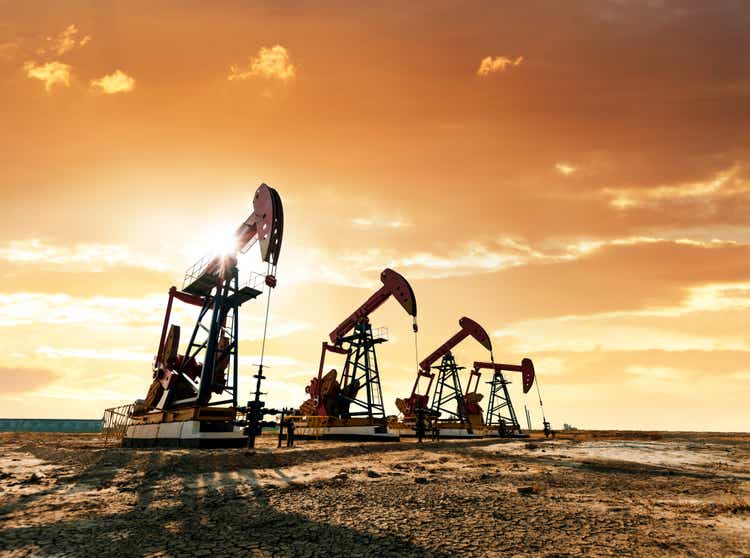
[ad_1]
baona
Ranger Oil (NASDAQ: ROCC) recently announced strong Q3 2022 preliminary results. It reported that total production was about 2% higher than the middle of the guidance range, and oil production was about 1% higher than the middle of the guidance range range Ranger’s capex was in line with expectations for the quarter, and the company appears to be successfully managing supply chain inflation and service cost issues that led some manufacturers to report significantly lower-than-expected production, with no capex benefits .
Ranger’s net debt at the end of 2022 may be slightly higher than I previously expected due to a third rig coming on stream in the fourth quarter of 2022 (vs. previous plans for two rigs during the quarter). However, production of the 2023 Ranger will benefit from this additional investment. I have now raised my estimate for the Ranger to around $42-$43 long-term (post-2023) at $70 WTI.
Reliable production performance
Ranger reported production of about 42,600 bpd in the third quarter of 2022, above the guidance range of 40,900 bpd to 42,500 bpd for total production. Oil volumes (about 30,700 bpd) were within the estimated range of 29,900 bpd to 31,100 bpd, but slightly above the estimated midpoint of 30,500 bpd.
Cost management
Producers are dealing with supply chain issues (resulting in completion delays) and service cost inflation, but Ranger Oil seems to be handling it pretty well. Ranger’s Q3 2022 capital expenditures at D&C were $151.9 million, within an estimated total capex range of $135 million to $160 million. It noted that $3.4 million of capital expenditures in Q3 2022 were related to D&C operations that were completed early. Excluding that $3.4 million, its capital spending for 3Q2022 would be very close to the midpoint of its guidance range for the quarter. Ranger also noted that it is finding “innovative ways” to offset cost-of-service inflation and complete wells on time and on budget.
The Ranger will likely benefit a bit from the Eagle Ford focus as well. While the Eagle Ford is also dealing with service cost inflation and supply chain bottlenecks, the situation there is not as bad as the Permian Basin. Callon Petroleum said it accelerated part of its Eagle Ford development program because of the Permian bottlenecks it was experiencing.
Prospects for the future
At current rates (and with its strong production numbers), Ranger is expected to generate approximately $170 million in positive cash flow in the second half of 2022, based on its development plans (as of August) for the rest of the year.
However, Ranger changed his plans. Two rigs were previously expected to be installed in the fourth quarter of 2022, following the deployment of a third rig during the second quarter of 2022 and the third quarter of 2023. However, three rigs are now scheduled to be operational by the end of 2022. This could put D&C capital expenditures closer to $150 million in the fourth quarter of 2022, compared to the roughly $100-$110 million I previously expected.
These additional costs would have a minimal impact on 2022 results, but would benefit Ranger’s 2023 results. Ranger also noted that it could continue to operate three rigs through 2023, which would result in significant production growth if the three-rig development plan continues throughout the year. A two-rig development program through 2023 is likely to hold production to low-single-digit growth from 2H2022 levels, while a three-rig development program could lead to around 10% growth from 2H22 levels.
Assessment notes
I’ve raised the Ranger’s valuation slightly due to its better-than-expected production numbers combined with its ability to keep costs under control in an inflationary environment.
In a scenario where oil and gas stay at current levels until the end of 2023, and then after 2023, WTI averages $70 and NYMEX gas $4.00 (my base case), now I value Ranger at around $42-$43 per share. It can further increase its value through continued efficient development of its assets.
Conclusion
Ranger Oil managed to avoid the supply chain problems that have plagued some other producers, allowing it to exceed production expectations in the third quarter of 2022. In addition, it added a third rig again in the fourth quarter of 2022 and could see production rise by around 10% in 2023 compared to the second half. 2022 levels if it goes with the three-rig development program for the entire year. Ranger’s solid production results (while meeting expected capex) help drive its value to around $42-$43 per share under a long-term $70 WTI oil price scenario.
[ad_2]
Source link
